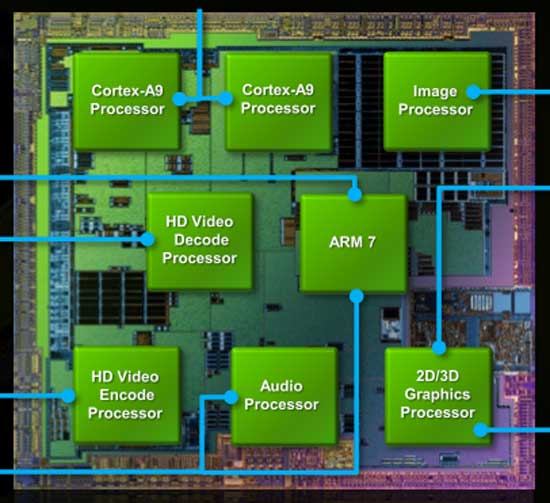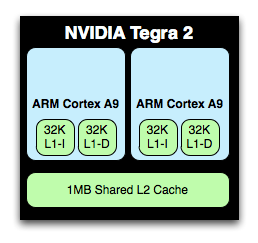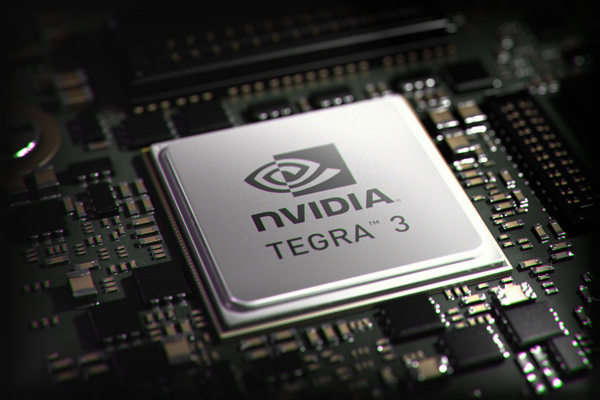NVIDIA's Tegra 3 Launched: Architecture Revealed
by Anand Lal Shimpi on November 9, 2011 12:34 AM ESTOriginally announced in February of this year at MWC, NVIDIA is finally officially launching its next-generation SoC. Previously known under the code name Kal-El, the official name is Tegra 3 and we'll see it in at least one product before the end of the year.
Like Tegra 2 before it, NVIDIA's Tegra 3 is an SoC aimed at both smartphones and tablets built on TSMC's 40nm LPG process. Die size has almost doubled from 49mm^2 to somewhere in the 80mm^2 range.
The Tegra 3 design is unique in the industry as it is the first to implement four ARM Cortex A9s onto a chip aimed at the bulk of the high end Android market. NVIDIA's competitors have focused on ramping up the performance of their dual-core solutions either through higher clocks (Samsung Exynos) or through higher performing microarchitectures (Qualcomm Krait, ARM Cortex A15). While other companies have announced quad-core ARM based solutions, Tegra 3 will likely be the first (and only) to ship in an Android tablet and smartphone in 2011 - 2012.

NVIDIA will eventually focus on improving per-core performance with subsequent iterations of the Tegra family (perhaps starting with Wayne in 2013), but until then Tegra 3 attempts to increase performance by exploiting thread level parallelism in Android.
GPU performance also sees a boon thanks to a larger and more efficient GPU in Tegra 3, but first let's talk about the CPU.
Tegra 3's Four Five Cores
The Cortex A9 implementation in Tegra 3 is an improvement over Tegra 2; each core now includes full NEON support via an ARM MPE (Media Processing Engine). Tegra 2 lacked any support for NEON instructions in order to keep die size small.

NVIDIA's Tegra 2 die

NVIDIA's Tegra 3 die, A9 cores highlighted in yellow
L1 and L2 cache sizes remain unchanged. Each core has a 32KB/32KB L1 and all four share a 1MB L2 cache. Doubling core count over Tegra 2 without a corresponding increase in L2 cache size is a bit troubling, but it does indicate that NVIDIA doesn't expect the majority of use cases to saturate all four cores. L2 cache latency is 2 cycles faster on Tegra 3 than 2, while L1 cache latencies haven't changed. NVIDIA isn't commenting on L2 frequencies at this point.


The A9s in Tegra 3 can run at a higher max frequency than those in Tegra 2. With 1 core active, the max clock is 1.4GHz (up from 1.0GHz in the original Tegra 2 SoC). With more than one core active however the max clock is 1.3GHz. Each core can be power gated in Tegra 3, which wasn't the case in Tegra 2. This should allow for lightly threaded workloads to execute on Tegra 3 in the same power envelope as Tegra 2. It's only in those applications that fully utilize more than two cores that you'll see Tegra 3 drawing more power than its predecessor.
The increase in clock speed and the integration of MPE should improve performance a bit over Tegra 2 based designs, but obviously the real hope for performance improvement comes from using four of Tegra 3's cores. Android is already well threaded so we should see gains in portions of things like web page rendering.
It's an interesting situation that NVIDIA finds itself in. Tegra 3 will show its biggest performance advantage in applications that can utilize all four cores, yet it will be most power efficient in applications that use as few cores as possible.
There's of course a fifth Cortex A9 on Tegra 3, limited to a maximum clock speed of 500MHz and built using LP transistors like the rest of the chip (and unlike the four-core A9 cluster). NVIDIA intends for this companion core to be used for the processing of background tasks, for example when your phone is locked and in your pocket. In light use cases where the companion core is active, the four high performance A9s will be power gated and overall power consumption should be tangibly lower than Tegra 2.
Despite Tegra 3 featuring a total of five Cortex A9 cores, only four can be active at one time. Furthermore, the companion core cannot be active alongside any of the high performance A9s. Either the companion core is enabled and the quad-core cluster disabled or the opposite.
NVIDIA handles all of the core juggling through its own firmware. Depending on the level of performance Android requests, NVIDIA will either enable the companion core or one or more of the four remaining A9s. The transition should be seamless to the OS and as all of the cores are equally capable, any apps you're running shouldn't know the difference between them.











94 Comments
View All Comments
mwarner1 - Wednesday, November 9, 2011 - link
Did you actually read the article?whsmnky - Wednesday, November 9, 2011 - link
As stated in the article, they'll have more once they have something in hand like they have in every other item review. Without physically having the product to test, I'm curious how you would expect them to provide ACTUAL battery life numbers to be able to hold anyone accountable to anything.MrSewerPickle - Wednesday, November 9, 2011 - link
Yeah I agree with both of the replies to this original comment. And please do NOT change the content, format or delivery of any of your Reviews or articles Anand. They are top-notch and rare on tech websites. Perfectly covered BTW and the Tegra 3 GPU is indeed a concern, in my humble opinion.cjs150 - Wednesday, November 9, 2011 - link
Perfect for a low power, low heat, no noise HTPC?Zotac have released the incredibly cute Nano AD10 (and one with Via chip in).
NVidia come on you can beat them with something as cute but better (no fan for starters!), you did tease with something like the nano box about a year or 2 ago
krumme - Wednesday, November 9, 2011 - link
HTPC: you can already have bobcat based, no fan solutions. All running x86. At around the same size. Would be nice with some benchmarks comparing this to bobcat, especially fpu part. LOL.iwod - Wednesday, November 9, 2011 - link
Would love to known how it perform against the A5.roundhouse_c - Wednesday, November 9, 2011 - link
Here is another article:
http://www.slashgear.com/tsmc-starts-28nm-producti...
Tegra 3 on 28nm die will be out sooner then what's being posted here.
eddman - Wednesday, November 9, 2011 - link
Kal-El+ must be 28 nm. It wouldn't make sense if it isn't.ezekiel68 - Wednesday, November 9, 2011 - link
From the article you linked:"AMD and NVIDIA saying they will be using the 28nm process silicon in
their next-gen graphics products."
The near-term timeframe is in reference to NVIDIA's next generation Kepler GPUs, not their mobile device SOCs. See also:
http://vr-zone.com/articles/nvidia-28nm-kepler-pro...
eddman - Wednesday, November 9, 2011 - link
True, but it doesn't mean that they are NOT working on a 28 nm tegra. 28 nm GPUs will start rolling out in Q1 2012, so a 28 nm tegra 3+ in mid 2012 isn't unrealistic.